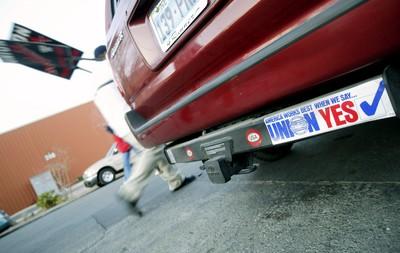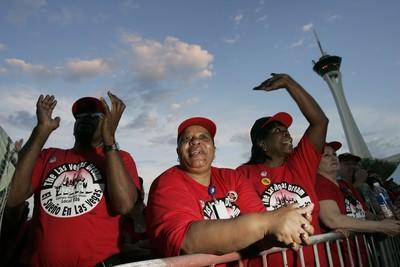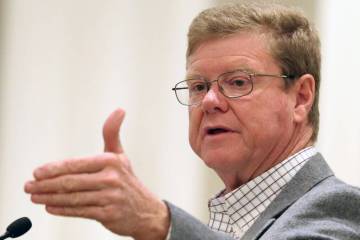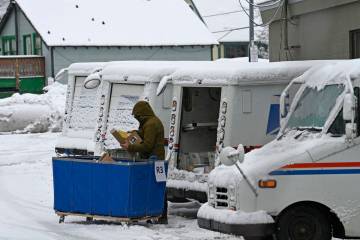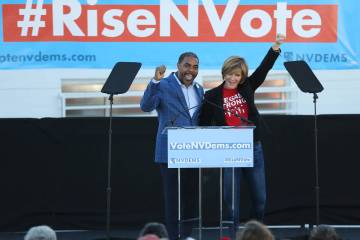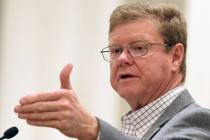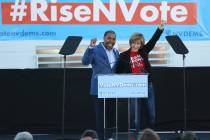STATE OF THE UNIONS
Labor unions have seen better days.
The country's share of union members has declined since 1983, the first year for which the federal Bureau of Labor Statistics has data comparable with today's measures.
The proportion of American workers belonging to unions in 1983 was 20.1 percent. Today, 12 percent of American workers are in unions.
Nevada's union membership fell in recent years, too, dropping from a peak of 20.4 percent in 1997 to 12.5 percent in 2004. But since then, Nevada's labor-group membership has bucked national trends.
Union membership in the Silver State rose to 13.8 percent in 2005 and to 14.8 percent in 2006. Union representation increased from 15.1 percent in 2005 to 17 percent in 2006.
That means 167,000 workers out of a total Nevada labor force of 1.1 million belonged to unions in 2006, while 191,000 workers in the state were covered by union contracts.
Just two states -- Arizona and Montana, at 1.5 percent each -- had higher growth in union membership in 2006 than Nevada. Only Arizona posted a bigger gain in union representation.
The rise in Nevada's union membership could spark increasing conflict between business leaders and labor officials. Business advocates say unions are no longer necessary in today's economy, while organizers say their groups will be essential as long as corporations exist. And both sides are at growing odds over public policies, workplace issues and the future of the local economy.
LABOR LOOKS TO ORGANIZE
Experts attribute Nevada's growing union base to several factors.
Karen Boroff, dean of the Stillman School of Business at Seton Hall University in New Jersey, says some of Nevada's biggest industries -- entertainment, hospitality, construction, health care and education -- are historically union-heavy. Fast growth in those arenas is bringing an accompanying rise in unionization.
Union membership in the private sector clocked in at 7.4 percent nationwide in 2006. Union coverage in the industries prevalent in Nevada is significantly higher.
Transportation and utilities, which make up 18 percent of Nevada's job base, according to the state Department of Employment, Training & Rehabilitation, have a nationwide unionization rate of 23.2 percent. Construction claims 11 percent of the state's jobs and a 13 percent unionization share. Government composes 12 percent of Nevada's job base, and 36.2 percent of the public sector's workers nationwide belong to unions. Among local government workers such as teachers, police officers and firefighters, union membership is 41.9 percent.
Other observers give partial credit for union growth to what they believe are growing inequities between Nevada's workers and managers.
Bob Fulkerson, executive director of the Progressive Leadership Alliance of Nevada, says reports of big paydays for local business executives have rankled the rank and file.
"The CEO of Harrah's (Gary Loveman) is making a little under $7,000 an hour, which is about 1,000 times more than the lowest-paid (leisure-sector) workers are making," Fulkerson says. "When workers see that, they realize the only way for them to be able to have a hand in that pie is through organizing."
Intensive organizing efforts by local labor leaders have propelled unions' growth also, Fulkerson says.
"We have some brilliant and dedicated organizers and leaders," Fulkerson says. "I think the (labor) leaders in Nevada are stars."
Some of Nevada's biggest unions -- the AFL-CIO, the Culinary and the Service Employees International Union -- have major organizing drives under way in Nevada.
Steven Miller, policy director of the libertarian Nevada Policy Research Institute, says unions are targeting Nevada as an organizing base because, unlike manufacturing jobs, tourism jobs "cannot run away."
"Hospitality and tourism is not the kind of business that can pick up and move," Miller says. "The employees of the resorts have to be here to provide the service, and thus, in many respects, this is one industry where the unions have additional leverage."
That economic immobility is tantalizing to unions, which have seen 2.5 million American jobs in manufacturing shipped out since 2000 to countries with cheaper labor, according to numbers from the AFL-CIO.
HOW IMPORTANT ARE UNIONS?
The trend toward moving business operations offshore is partly behind the precipitous decline in nationwide union membership since the 1980s, labor leaders say.
They also point to other factors, from shifting priorities on social issues to the rising power of a political-business industrial complex that's increasingly hostile to the interests of workers and labor organizations.
Competing movements from women's liberation and civil rights to anti-Vietnam activism splintered the New Deal coalition that yielded the organized-labor movement in the early 20th century, says Bruce Nissen, director of research at Florida International University's Center for Labor Research and Studies.
Even more damaging to unions was President Reagan's 1981 decision to fire 11,350 striking members of the Professional Air Traffic Controllers Association, says Jane McAlevey, executive director of the Nevada chapter of the SEIU.
In a ruling after the firing, the National Labor Relations Board found that an employer could replace striking workers permanently if a walkout is based on wages or other economic demands.
The decision launched a "cottage industry" in union-busting, and it "has terrified workers and blunted unions' most powerful tool," which is going on strike, McAlevey says.
McAlevey also acknowledges that some unions grew slack over the past two decades in chasing fresh organizing opportunities.
"There's a teeny bit of blame on unions themselves for falling asleep at the switch," she says.
Some observers say unions bear substantially more blame for their dwindling ranks.
The American economy might have shed 2.5 million manufacturing jobs in the past seven years, but the Bureau of Labor Statistics has reported the creation of 7.2 million new jobs in the United States since 2003. And contrary to what union officials say, there's little barrier to organizing a workplace, says Las Vegas employers' attorney Mark Ricciardi.
"Any employee group that gets the appropriate number of (union) authorization cards signed can march down to the National Labor Relations Board" and request a vote to organize, says Ricciardi, a partner in the law firm of Fisher & Phillips.
So why haven't unions been able to convert a growing business sector into an expanding union base?
Because organized labor is no longer necessary, union detractors say. A global, competitive economy and changing business models are altering the relationships between employers and employees, and countless federal and state laws now govern workers-rights issues from workplace safety to discrimination on the job, they say.
Gone are the days when workers would take a job with a major local employer and stay with the company for the duration of their productive years, says Ivan Osorio, a labor researcher at the Competitive Enterprise Institute in Washington.
"That model is obsolete now, and unions, to their detriment, have not adapted," Osorio says.
Benefits such as retirement are increasingly financed by workers themselves through mechanisms such as 401(k) accounts, Boroff says, so employees are more mobile and can "vote with their feet" to abandon an unpleasant working environment. That, plus a nationwide unemployment rate of 4.5 percent and a statewide jobless rate of 4.3 percent, can force even nonunion companies to be on their best behavior.
"Employers rarely abuse workers anymore," Miller says. "There's too much demand for good workers. There's even demand for medium-skilled or medium-ability workers."
Kara Kelley, president and chief executive officer of the Las Vegas Chamber of Commerce, says her organization's members struggle every day to lure scarce talent. Nabbing the best and the brightest, she said, means offering health insurance, 401(k) plans, competitive wages, tuition assistance, flexible schedules and housing assistance.
"Businesses are trying to do as much as they can to be creative," Kelley says. "They want to create a positive work atmosphere and a good benefits package so that employees want to stay with them and dedicate time to the business. It's so easy for workers to find 10 other offers if they're not happy."
The possibility of new opportunities and improved benefits means fewer people see the need for a third party to collect dues and negotiate benefits for them, Ricciardi says.
"People are happier speaking for themselves," he says.
Where employees face obstacles to speaking for themselves, a network of agencies and laws steps in to help, Ricciardi says.
The Occupational Safety and Health Administration sets and enforces standards to protect American workers on the job. In March, the agency, which provides safety training and assistance to companies, identified and named on their Web site 14,000 companies nationally that have higher-than-average rates of illness and injury on the job.
The Equal Employment Opportunity Commission fields and investigates claims of workplace discrimination based on characteristics such as age, gender, disability, pregnancy, religion and nation of origin. The commission won a $47 million settlement on a gender-discrimination claim against Rent-A-Center stores nationwide in 2002, a $34 million sex-discrimination settlement from Mitsubishi in 1998 and a $10 million gender-discrimination settlement from Dial Corp. in 2003.
And state bureaus are tasked with sheltering workers' rights. The Nevada State Labor Commission opened 2,644 claims in between July 1, 2005, and June 30, 2006, Labor Commissioner Michael Tanchek says. Most of those complaints involved unpaid wages, but the agency also considers claims involving meal or coffee breaks and provides workers with guidance on questions about delayed paychecks, changing salaries, federal withholding, record-keeping, the minimum wage and who pays for uniforms required on the job.
Workers compensation insurance pays employees injured on the job, and the Employee Retirement Income Security Act protects workers enrolled in pensions or health plans. The retirement act requires transparency, allowing employees to know the designs of their benefit plans, and it gives workers the right to sue for benefits and to sue employers for breaches of fiduciary duty.
American workers have unions to thank for these and other improvements in employee protections. Organized labor has spearheaded such measures. In so doing, however, they've chipped away at their own importance, Boroff says.
"Because the unions have been such ardent supporters of workplace regulation, they've almost created competing mechanisms for themselves," Boroff says. "People might say, 'Why do we need a union?'"
Adds Miller, of the Nevada Policy Research Institute: "If the fees you paid for representation were worth it, employees would love this. But they don't believe it's worth it. There's not an actual market demand for unions' services anymore."
However, union officials and some labor analysts say they see plenty of need for unions today.
THE CASE FOR RELEVANCE
Exhibit A in the unions' argument for their necessity: The layoffs in late March of 3,400 hourly workers at Circuit City.
The electronics retailer let go higher-earning workers and announced plans to replace the employees immediately with lower-paid fresh hires. The staffers who were laid off can reapply for their jobs in 10 weeks, but if they're rehired, it will be at the new, lesser pay rate.
The AFL-CIO jumped on the incident in its Web log, noting, "Without the protection of a union and a collective-bargaining contract, the 3,400 workers have few options to fight back."
McAlevey, of the SEIU, says living wages and benefits don't materialize by themselves.
"At no time do employers wake up and say, 'I just want to give you a good retirement plan, a good health care plan and good wages,'" McAlevey said. "It's just not the world we live in."
As evidence, union leaders point to the pay differential between their members and workers who aren't organized.
The Culinary, which covers housekeepers, restaurant workers and other employees in the hospitality industry, has locked in wages 40 percent to 60 percent higher than comparable national averages for leisure-sector workers, says Secretary-Treasurer D. Taylor.
Pay for laborers covered through the AFL-CIO, including construction workers and machinists, outstrips compensation among nonunion workers in those sectors by as much as 25 percent, says Stewart Acuff, the union's national organizing director.
Among black workers, the discrepancy is 30 percent, and among Hispanics, the difference is 50 percent, Acuff adds.
Unions can affect the salaries and perks nonunion employers provide.
"We have raised wages in nonunion hospitals," McAlevey says. "We are responsible for wage inflation. Employers are paying a premium to keep the unions out. That's the beautiful story of labor's relevance. When we do our work, and we become a majority of workers in any market, that leads to greater privileges and benefits for all the workers in that region."
Plus, labor advocates say, the laws and public agencies designed to protect workers' rights are at best bureaucratic nightmares and at worst ineffective.
"We have language (in contracts) that says if something is not safe, we can address it right away," Taylor says. "We don't have to file it with the government and hope someone comes out two weeks from now to look at the situation and makes a ruling in four months."
Taylor also finds irony in conservative economists' directing workers toward government agencies for problem-solving, considering those analysts often demonize the competency of government in general.
For a brief time in the 1970s, federal agencies and laws had the funding, staffing and enforcement capabilities to work, McAlevey says. But private employers have spent half a century "quietly trying to subvert the laws," McAlevey says.
The result: Such mechanisms are largely nonfunctional today, she says.
Even some of the officials in charge of entities that hear workers' complaints see a place for unions.
Tanchek, of the Nevada Labor Commission, says public agencies can't negotiate basic agreements covering working conditions or benefits. He says a company's vacation policies, pay rates and health coverage are all between managers and workers.
The SEIU struck new contracts with local hospitals from 2004 to 2006 that changed health insurance coverage from a policy that workers helped pay for to a 100 percent employer-funded plan, McAlevey says, and the union is addressing nurse-to-patient ratios, too.
Unions can serve as a pressure valve for workplace conflict and a moral guide for employers, Boroff says.
"If a union functions well, it can help solve problems at a low level so they don't escalate into litigation, which is costly," she says. "A union can also provide an honest manager a level of consciousness to say, 'If this matter went to public scrutiny, am I really doing the right thing?' Unions still have value."
More employers could use such gut checks for fairness, Nissen says. As the Circuit City workers laid off because of their higher wages are learning, few laws prevent employers from arbitrarily firing workers.
"Survey after survey shows the No. 1 reason people join unions is not money: It's to be treated fairly and equitably," Nissen says. "People join unions for dignity on the job and a voice in the workplace. Unions provide the chance for ordinary working people without extraordinary skills or very high levels of education to have a political voice and bargain in a relationship with employers. It's difficult to see how you could replace that."
Business executives respond that choking enterprise with regulation could mean a smaller economic pie for everybody.
'THE SMALL MARGIN THAT KILLS'
The forward march of unions throughout Nevada could exact a heavy toll on the Silver State's fiscal soundness and economy in coming decades, some observers say.
From ever-higher wages and public policies that could force up the price of services to a pending, multibillion-dollar retirement liability for unionized workers in the public sector, economists and researchers say, Nevada must tread carefully. Otherwise, it could share the fate of the union-dominated Rust Belt, a swath of Eastern and Midwestern America where once-vibrant factories have succumbed to cheaper production overseas.
"The long-run impact of union power in America has been to damage economies," says Miller, of the Nevada Policy Research Institute. "America's Rust Belt is largely the product of organized labor's extralegal and political power. In so many of those Rust Belt states, unions were able to compel and bribe politicians into passing bad laws that made those states really hostile to business. That's why jobs are fleeing from those places."
The higher pay and fully funded health coverage that union members garner work today because Las Vegas doesn't have significant competition for its key services, Boroff says. Workers in India can't change bed sheets or bedpans in Las Vegas. To the extent that businesses can pass rising labor costs on to consumers who can't flee the market and obtain services elsewhere, Boroff says, the effects of unions in Nevada will not be significant.
She sounds a cautionary note, though.
The idea of competition in car manufacturing was unthinkable in Detroit in the 1950s and 1960s, and managers thus felt they could absorb pricier labor, Boroff says. Today, America's automakers are "severely threatened," she says, suffocating under legacy costs including retiree pensions and health care.
Legacy expenses tack on as much as $1,500 to the price of every General Motors car, and foreign manufacturers are surging past domestic carmakers in sales. American automakers and their suppliers are scrambling to shed tens of thousands of union jobs, and unemployment in states with major auto sectors, such as Michigan and Ohio, is well above the national average.
Las Vegas is not immune to competition, Boroff says. As global tourism markets emerge, potential local customers will have other, perhaps more affordable, vacation options than Las Vegas.
She cited Macau, where some of Las Vegas' biggest resort operators have opened hotel-casinos, as an illustration. And as technology improves, sectors such as health care will have more outsourcing options as well: reading X-rays sent electronically to Asia, for example.
"It would be best if both unions and management in Las Vegas and Nevada can think in a wholesome way about what their current costs might be for future legacy expenses 15 or 20 years down the road," Boroff says. "They should be thoughtful and reflective about doing things properly so people do not inherit these costs."
Miller says the prospective economic burdens unions place on the state aren't confined to the private sector.
Pensions for public employees in Nevada face an unfunded liability of $6 billion in a state where the biennial budget for 2007 to 2009 will come in at around $6.8 billion.
In 2004, then-Gov. Kenny Guinn suggested saving Nevada $500 million over 30 years by ending retirement health coverage for future hires working for the state.
Public-employee unions came out swinging at the measure, which was spurred partly by Guinn's observation that the taxpayers financing such largesse could hardly expect fully financed retirement health care of their own. The proposal died in the 2005 Legislature.
Now that unions have organized government workers, those employees "have the ability to basically step in front of the citizens of the state and make their own deals with government administrators," Miller says. "They are more equal than the rest of us. For the last 15 to 20 years, they have increasingly awarded themselves a better lifestyle at the expense of average Nevada taxpayers."
Bigger legacy costs for public workers aren't merely a matter of fairness.
A state's level of debt can change its bond rating, the standard that determines how much it will cost to borrow money to sustain state functions. Lower bond ratings mean higher interest rates on loans to the state, and taxpaying individuals and businesses must pick up that tab. Nevada's bond ratings are strong now, but pile on debt in the form of legacy costs, and that could change, experts say.
Business leaders say unions are pursuing public policies that could harm companies and lead to higher unemployment rates or fewer benefits.
They point in particular to the state's new minimum wage.
The minimum wage, which voters passed in November, requires that the Silver State's base hourly pay be $1 an hour higher than the federal floor and indexed annually to inflation. The measure exempted companies that provide health care to workers. It also waived the wage for businesses involved in collective-bargaining agreements with unions.
The chamber of commerce's Kelley says Nevada's businesses soon could see a minimum wage of as much as $10.50 an hour if whispers of raising the federal minimum to $9.50 an hour become reality in Washington.
Osorio, of the Competitive Research Institute, says the higher minimum wage is typical of the public policies unions pursue.
Most union members make well above the minimum wage, he says, so the new law, which the AFL-CIO sponsored, probably was designed less to give workers a raise than to hobble competition from nonunion businesses that use cheaper labor.
Kelley called it a frustrating double standard.
"The real hypocrisy is that if they really cared about workers, they wouldn't have exempted businesses under collective-bargaining agreements," she says.
Plus, increased labor costs could mean fewer jobs in general, Boroff says.
"Higher wages cause employers to not hire as much," Boroff says. "For some businesses, that higher wage might just be the small margin that kills them, especially for new companies trying to survive their first couple of years."
Unions are pursuing legally limited nurse-to-patient ratios in Nevada's hospitals. Hospital operators say that the mandates have led to increased emergency room wait times in other states and that the legal requirements would take away their staffing flexibility.
Policies that seem on their surface to help workers often have unintended consequences, Boroff says, and it's those unexpected developments that both unions and businesses must watch for as organized labor boosts its political activities in the state.
The Employee Retirement Income Security Act is heavy on rules governing how pensions and other benefits are administered. When it went into effect in 1974, employers began to ditch pensions altogether rather than endure the red tape involved in operating a retirement plan, Boroff says.
"Employees do need to be protected," Boroff says. "But more regulations just put more cost on businesses, and complying requires an awful lot of money. That's overhead, and overhead doesn't inspire innovation. That's my concern: The more legislation we have, the less resources there are for bringing products and services to market and distributing wealth to employees."
Leaders of organized labor respond that no mechanism is more effective than unions at distributing corporate wealth to the working class, and they say giving employees a greater share of their employers' riches will only help Nevada's economy.
GROWING A MIDDLE CLASS
The creation of a large middle class is perhaps the most important contribution unions have made to the American economy, the AFL-CIO's Acuff says.
The United States was the first country in the world where working people, not just shopkeepers or business owners, could aspire to the trappings of moderate affluence.
Homeownership, time-saving appliances and college educations for children all were made accessible to laborers by the higher wages and richer benefits that unions procured, Acuff says.
It's a dynamic in play in Nevada.
"You look at other tourist towns throughout the country, and you don't see dishwashers or cooks who can afford to send their kids to college," says Fulkerson, of the Progressive Leadership Alliance of Nevada. "You don't see dishwashers, cooks or bartenders who have retirement plans or who are buying homes. You see that in Las Vegas, and there's one reason alone for that: unions."
Organized labor continues to sustain parts of the American middle class with advantages such as fully funded health care, the Culinary's Taylor says.
Many workers are one health catastrophe away from financial ruin; union members spared the burden of health disaster can focus instead on homeownership, education and other long-term investments, Taylor says.
A vital middle class has important implications for the economic vibrancy of Nevada.
Higher pay means more spending power, which in turn translates into more income for Nevada's businesses, Acuff says. The typical worker's wages start at the bottom of the economy and turn over three to four times, he says, funding everything from business expansion to schools to churches.
"It's not that unions are a cure-all, but all things being equal, there's no question that countries do better when they have the mass purchasing power of a growing middle class," Florida International's Nissen says. "And countries tend to have a growing middle class when there are more unions."
A secure and well-paid work force spurs improved customer service, Fulkerson says. That sense of well-being comes across to tourists, who would bear the brunt of poor morale among hotel employees and reconsider returning to the market for future vacations, he adds.
Homeownership makes for less transience among families, and children will face fewer school transfers, Taylor says. Such stability improves students' quality of education and their career prospects.
When pay rises and property ownership increases, the state's revenue streams flow more freely. Numerous social programs benefit, including public schools, programs to prevent teen pregnancy and agencies that treat mental illness, McAlevey says.
"We're in major catch-up here," McAlevey said. "There's a lot of wealth in raw terms in Nevada, and yet we have terribly underfunded and underperforming schools. There's a ton of statistics we can't be too proud of in terms of social indicators. Unions are trying to level the playing field over how wealth is shared."
States with high rates of unionization have better outcomes in areas such as infant mortality and health insurance coverage than states with a smaller union presence, Nissen says.
"As long as you have bigger, stronger unions, you have an awful lot more legislation that provides for the social welfare of people," he says.
Labor leaders believe their policies will advance the health of Nevada's economy and businesses. A higher minimum wage will boost bottom lines as workers spend and invest more; lower nurse-to-patient ratios in the state's hospitals will improve health outcomes.
And in fostering workplace peace and stability, unions can help corporations operate more smoothly, Acuff says. Better working conditions yield more productive and more effectively trained employees, which bumps up efficiency, suppresses staffing turnover and increases employee longevity on the job, Acuff says.
As for the manufacturing jobs that organized labor's foes say unions have pushed offshore, Nissen says those jobs were bound to leave the country regardless of unionization. The global economy allows many products formerly made in the United States to be produced at equal standards of quality with "incredibly low labor costs," Nissen says.
Nissen points to Nevada's unemployment rate, 4.3 percent in February, and says the low level of joblessness provides no empirical basis for the notion that increasing union power correlates to business stagnation.
Nevada falls within the top 10 states in the number of workers represented by unions, yet the Silver State also has one of the country's strongest economies, with annual job growth clocking in at around 5 percent.
In considering Nevada's increasing unionization rates and its long-term prospects for growth, Nissen does not find any significant lessons.
"Considering what happens 10 or 20 years from now is an absurd way to look at the world," he says. "It makes no sense. There's no end to that kind of logic. The end result is that we all ought to be slaves working for nothing. What is the purpose of the economy? Is it the welfare of the people? Or will people's welfare be reliant on a growing GDP? Do people serve the economy, or is the economy there to serve people?"
Despite growing union ranks, Las Vegas' biggest businesses have thrived in recent years, Taylor says. Hotels on the Strip are charging more for rooms and restaurant meals than ever, and workers' wages haven't always kept up.
"Clearly, the industry here has demonstrated how to both be highly profitable and be union," Taylor says. "I have no doubt that the industry as a whole will continue to do that. Whether we like it or not, we have a very symbiotic relationship with the industry. As they do well, we do well. If they don't do well, it affects us. We have a vested interest in the industry being creative, being ahead of the curve and being a part of growth."
MEMBERS INCREASE
Union membership increased in 17 states in 2006. Below are the growth states for unions, ranked by percentage gains in labor membership in each state's total work force:
| State | Union membership | ||
| 2005 | 2006 | Change | |
| Arizona | 6.1% | 7.6% | 1.5% |
| Montana | 10.7% | 12.2% | 1.5% |
| Kansas | 7.0% | 8.0% | 1.0% |
| Nevada | 13.8% | 14.8% | 1.0% |
| Oklahoma | 5.4% | 6.4% | 1.0% |
| South Carolina | 2.3% | 3.3% | 1.0% |
| Idaho | 5.2% | 6.0% | 0.8% |
| Washington | 19.1% | 19.8% | 0.7% |
| Massachusetts | 13.9% | 14.5% | 0.6% |
| Tennessee | 5.4% | 6.0% | 0.6% |
| Utah | 4.9% | 5.4% | 0.5% |
| North Carolina | 2.9% | 3.3% | 0.4% |
| Wyoming | 7.9% | 8.3% | 0.4% |
| Arkansas | 4.8% | 5.1% | 0.3% |
| Minnesota | 14.7% | 15.0% | 0.3% |
| Vermont | 10.8% | 11.0% | 0.2% |
| Kentucky | 9.7% | 9.8% | 0.1% |
| United States | 12.5% | 12.0% | -0.5% |
SOURCE: BUREAU OF LABOR STATISTICS
representation on the rise
Union representation grew in 15 states in 2006. Below are the top states for expansion of union coverage, ranked by rate of increase in each state's total work force:
| State | Union membership | ||
| 2005 | 2006 | Change | |
| Arizona | 7.7% | 9.7% | 2.0% |
| Nevada | 15.1% | 17.0% | 1.9% |
| Oklahoma | 6.4% | 7.7% | 1.3% |
| Idaho | 6.3% | 7.2% | 0.9% |
| Montana | 12.2% | 13.1% | 0.9% |
| South Carolina | 3.3% | 4.2% | 0.9% |
| New Mexico | 10.7% | 11.5% | 0.8% |
| Washington | 20.4% | 21.0% | 0.6% |
| Iowa | 13.5% | 14.0% | 0.5% |
| Wyoming | 9.5% | 10.0% | 0.5% |
| Kentucky | 10.8% | 11.2% | 0.4% |
| Massachusetts | 14.9% | 15.3% | 0.4% |
| Minnesota | 16.4% | 16.8% | 0.4% |
| North Carolina | 3.9% | 4.1% | 0.2% |
| Tennessee | 6.6% | 6.8% | 0.2% |
Source: Bureau of Labor Statistics



